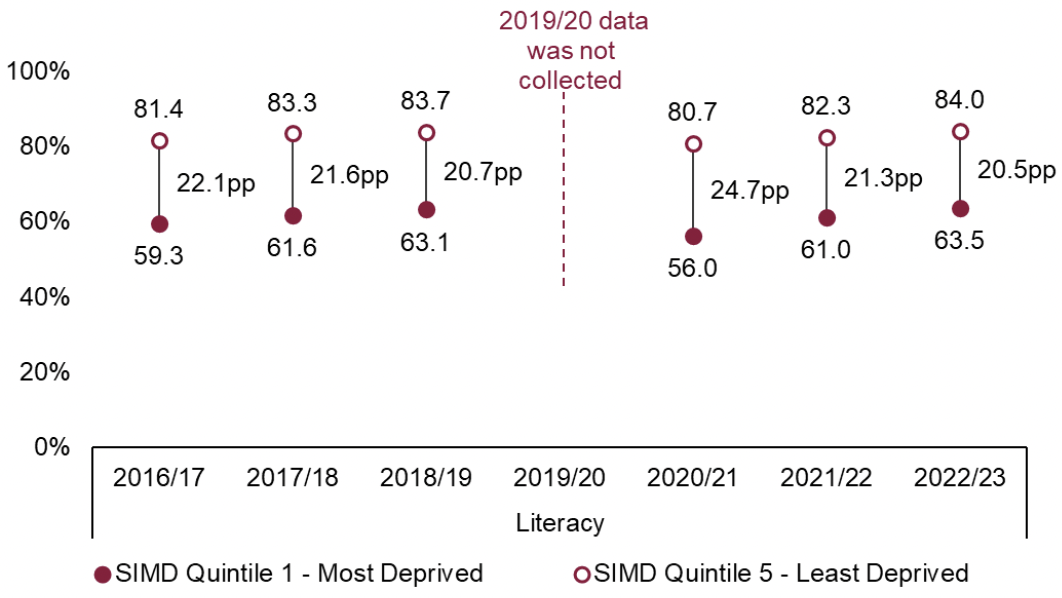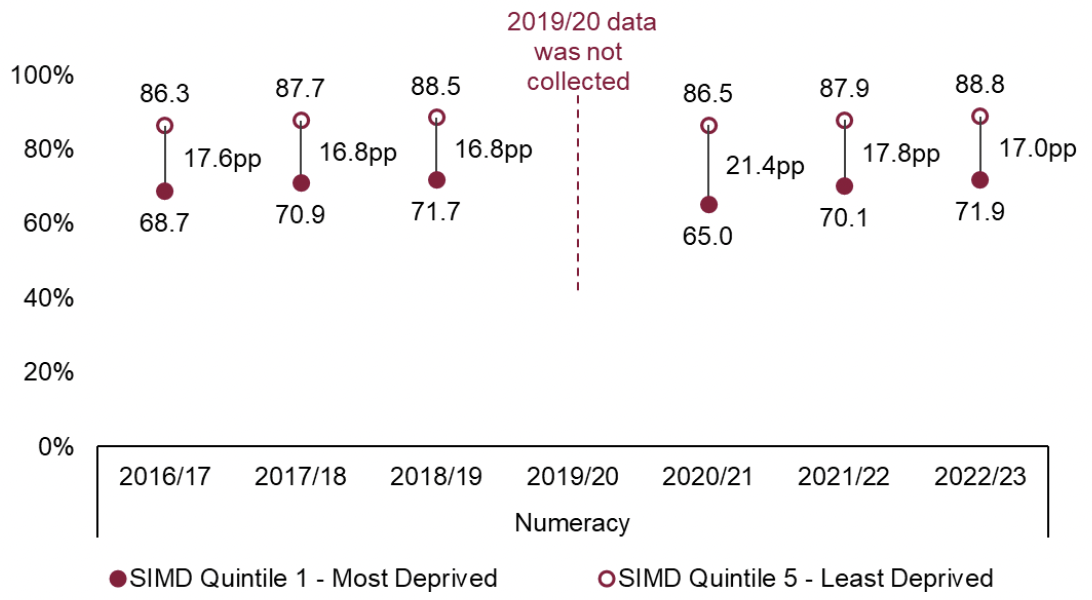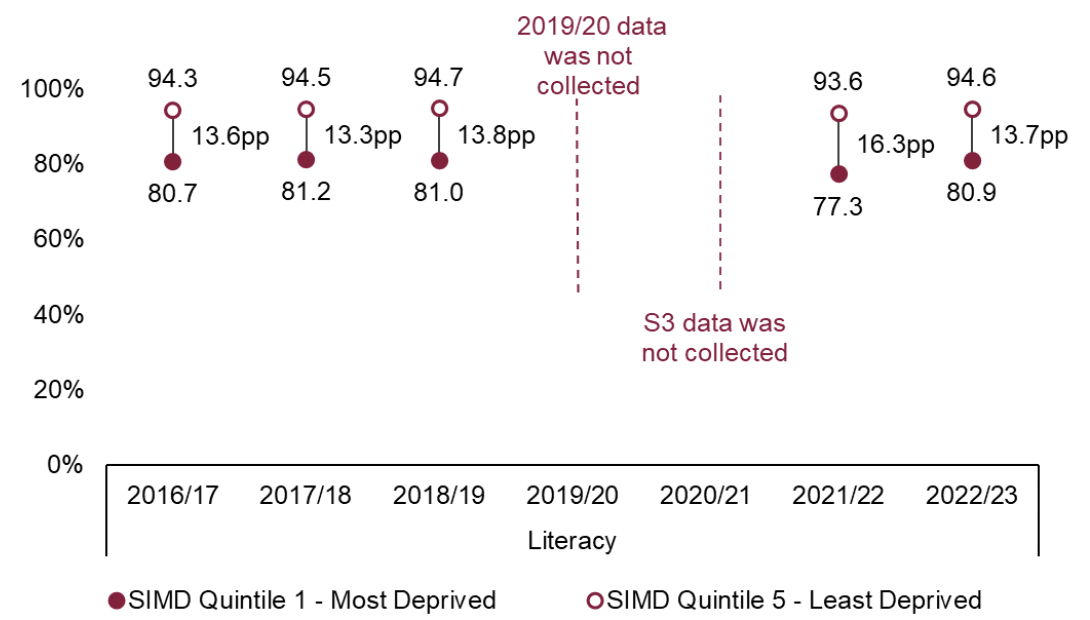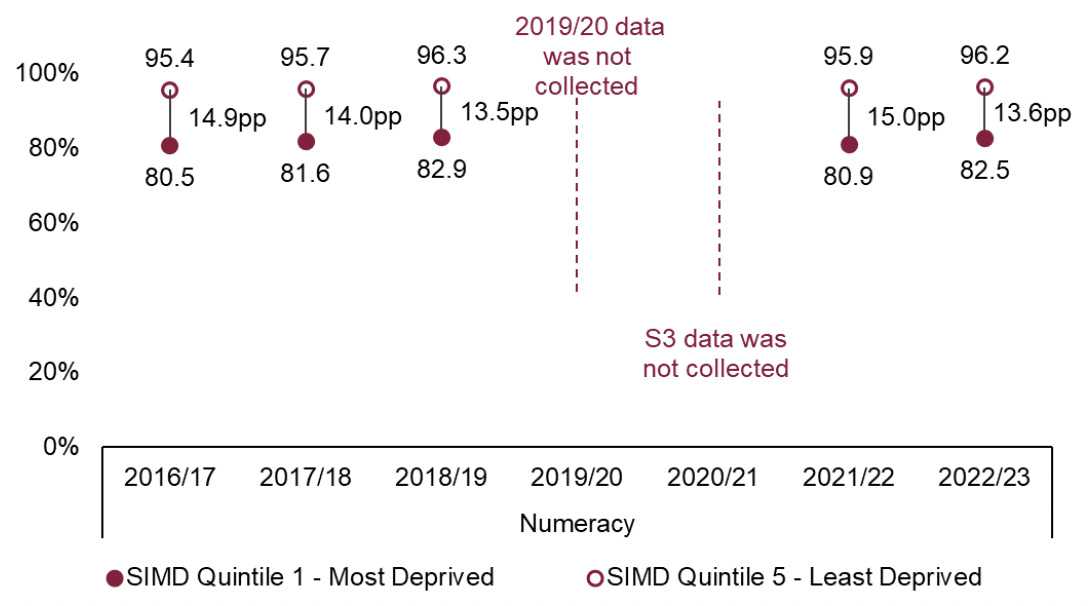Achievement of Curriculum for Excellence (CfE) levels: 2022/23
Achievement of Curriculum for Excellence (CfE) levels: 2022/23 provides information on national performance in literacy and numeracy, based on all pupils in publicly funded Primary 1, Primary 4, Primary 7 and Secondary 3 classes, and for all pupils based in special schools/units.
This document is part of a collection
Chapter 3: Achievement of CfE Levels by Deprivation
Key Findings
- The gap between the proportion of primary school pupils (P1, P4 and P7 combined) from the most and least deprived areas who achieved the expected level in literacy narrowed from 21.3 percentage points in 2021/22 to 20.5 percentage points in 2022/23 – the smallest on record (since 2016/17).
- The gap between the proportion of primary school pupils (P1, P4 and P7 combined) from the most and least deprived areas who achieved their expected level in numeracy narrowed from 17.8 percentage points in 2021/22 to 17.0 percentage points in 2022/23 – slightly wider than in 2018/19 (16.8pp).
- The gap between the proportion of S3 pupils from the most and least deprived areas who achieved Third Level or better in literacy reduced from 16.3 percentage points in 2021/22 to 13.7 percentage points in 2022/23 – similar to pre-pandemic levels.
- The gap between the proportion of S3 pupils from the most and least deprived areas who achieved Third Level or better in numeracy narrowed from 15.0 percentage points in 2021/22 to 13.6 percentage points in 2022/23 – similar to the level in 2018/19 (13.5pp).
This chapter provides an overview of Achievement of CfE Levels by pupils based on the deprivation level of the area they live in, as measured by the Scottish Index of Multiple Deprivation (SIMD). It provides information on literacy and numeracy for P1, P4 and P7 pupils combined and for S3 pupils. Full details (including all stages, organisers and SIMD quintile categories) are available in the supplementary tables.
When considering data by SIMD as a measure of multiple deprivation, it is important to note that the data show the difference between young people living in the most and least deprived areas. What SIMD does not show is the difference between young people from poor or rich backgrounds.
The figures shown in Charts 1, 2, 3 and 4 provide four of the 13 key National Improvement Framework measures used to measure the poverty-related attainment gap. These key measures are:
- Percentage of P1, P4 and P7 pupils combined achieving expected Level in Literacy;
- Percentage of P1, P4 and P7 pupils combined achieving expected Level in Numeracy;
- Percentage of S3 pupils achieving Third Level or better in Literacy and;
- Percentage of S3 pupils achieving Third Level or better in Numeracy.
The charts show Achievement of CfE Levels by SIMD since 2016/17, with the ‘pp’ abbreviation indicating percentage point difference between pupils from the most and least deprived areas (referred to as the attainment gap).
3.1 Achievement of CfE Levels by Deprivation – P1, P4 and P7 pupils
Chart 1 provides information on the percentages of P1, P4 and P7 pupils combined who achieved the expected levels in literacy.
The attainment gap between pupils from the most and least deprived areas narrowed from 21.3 percentage points in 2021/22 to 20.5 percentage points in 2022/23. This is very slightly narrower than in 2018/19 (20.7 percentage points) and also narrower than in 2017/18 (21.6pp) or 2016/17 (22.1pp).
The proportions of P1, P4 and P7 pupils combined achieving the expected level in literacy increased in 2022/23 compared to 2021/22 for pupils in both the most and least deprived areas. Both are now at their highest level since 2016/17 – the first year for which comparisons can be made. Between 2021/22 and 2022/23 the proportion increased more for pupils from the most deprived areas which has led to the gap narrowing.

Chart 2 provides information for P1, P4 and P7 pupils combined who achieved the expected levels in numeracy.
The numeracy attainment gap narrowed from 17.8 percentage points in 2021/22 to 17.0 percentage points in 2022/23. This is slightly wider than it was in 2017/18 and 2018/19.
Compared to 2021/22, the proportions of P1, P4 and P7 pupils combined achieving the expected numeracy levels have increased for both pupils in the most and least deprived areas in 2022/23. Both are now slightly higher than in 2018/19 and at their highest levels since 2016/17 – the first year for which comparisons can be made. The gap has narrowed since 2021/22 as the proportion increased by nearly twice as much for pupils from the most deprived areas.

3.2 Achievement of CfE Levels by Deprivation – S3 pupils
Chart 3 shows the proportion of S3 pupils who achieved Third Level or better in literacy, for pupils in the most and least deprived areas.
The chart shows that the proportion of S3 pupils who achieved Third Level or better in literacy remained broadly stable between 2016/17 and 2018/19, for pupils from both the most and the least deprived areas. The proportions then decreased for both groups in 2021/22, falling by more for pupils from the most deprived areas. In 2022/23 they have returned to around the levels seen prior to the pandemic for both groups.
The S3 pupils attainment gap in literacy has narrowed from 16.3 percentage points in 2021/22 to 13.7 percentage points in 2022/23. This is similar to the level seen in 2018/19.

Chart 4 shows the proportion of S3 pupils who achieved Third Level or better in numeracy, for pupils in the most and least deprived areas.
The S3 pupils attainment gap for Third Level or better in numeracy narrowed from 14.9 percentage points in 2016/17 to 14.0 percentage points in 2017/18 and to 13.5 percentage points in 2018/19 (see Chart 4 below). In 2021/22, the gap widened to 15.0 percentage points. 2022/23 has seen the gap reduce to 13.6 percentage points – very similar to the level seen in 2018/19.
The proportion of S3 pupils who achieved Third Level or better in numeracy in 2022/23 is higher than in 2021/22 for pupils from both the most and the least deprived areas although both remain slightly below the 2018/19 levels.

Contact
Email: school.stats@gov.scot
There is a problem
Thanks for your feedback